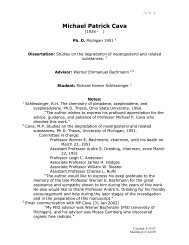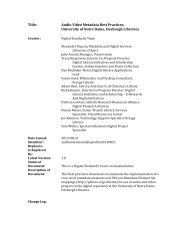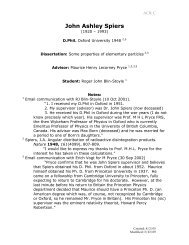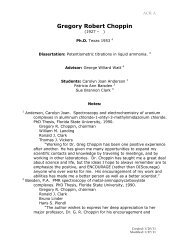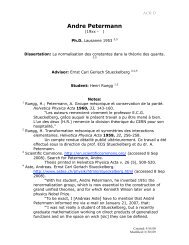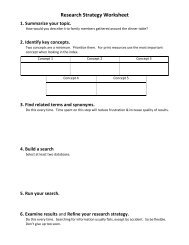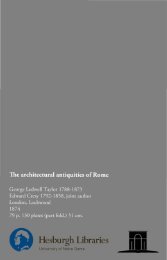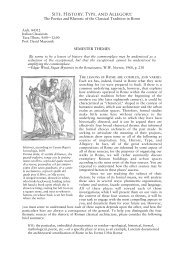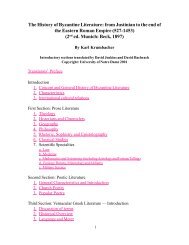Exploring the American Dream, Past and Present - University of ...
Exploring the American Dream, Past and Present - University of ...
Exploring the American Dream, Past and Present - University of ...
- No tags were found...
You also want an ePaper? Increase the reach of your titles
YUMPU automatically turns print PDFs into web optimized ePapers that Google loves.
From <strong>the</strong> Director…Bringing Users <strong>and</strong> Knowledge Toge<strong>the</strong>rIt is a pleasure to announce <strong>the</strong> start <strong>of</strong> planning for <strong>the</strong> renovation<strong>of</strong> <strong>the</strong> Hesburgh Library. The <strong>University</strong> has selected ShepleyBulfinch Richardson <strong>and</strong> Abbott, a renowned Boston architecturalfirm with numerous awards for design excellence. The firm hasdesigned many research libraries including <strong>the</strong> recent expansion<strong>and</strong> renovation <strong>of</strong> Perkins Library, Duke <strong>University</strong>, where <strong>the</strong>design “repositions <strong>the</strong> library as <strong>the</strong> centerpiece <strong>of</strong> a dynamiclearning <strong>and</strong> research community, creating a balance <strong>of</strong> spatialtypes <strong>and</strong> environments that will support <strong>the</strong> <strong>University</strong>’s evolvingneeds <strong>and</strong> uses.” As we plan for <strong>the</strong> renovation <strong>of</strong> <strong>the</strong> first <strong>and</strong> secondfloors <strong>of</strong> <strong>the</strong> Hesburgh Library, we too have an unprecedentedopportunity to redefine <strong>the</strong> teaching, learning <strong>and</strong> research environments in <strong>the</strong> Libraries. Inthis issue, Denise Shorey, associate director for User Services, introduces some <strong>of</strong> <strong>the</strong> ways inwhich we will transform <strong>the</strong> physical library (see page 3). In <strong>the</strong> end, <strong>the</strong> integration <strong>of</strong> libraryresources, services <strong>and</strong> users in revitalized spaces will enhance support for <strong>the</strong> <strong>University</strong>’sgoals <strong>of</strong> <strong>of</strong>fering an unsurpassed undergraduate experience <strong>and</strong> becoming a preeminentresearch university.The convergence <strong>of</strong> new technologies for delivering information <strong>and</strong> <strong>the</strong> “beautiful bones”<strong>of</strong> <strong>the</strong> building allow us to think creatively <strong>and</strong> plan, not only for <strong>the</strong> present, but also in anticipation<strong>of</strong> future needs. We can reconfigure spaces so that, for instance, humanities scholarshave a digital laboratory where <strong>the</strong>y can explore resources <strong>and</strong> contribute to scholarship at <strong>the</strong>highest level. We can take advantage <strong>of</strong> new principles <strong>of</strong> pedagogy <strong>and</strong> new modes <strong>of</strong> learningby designing many types <strong>of</strong> spaces for learning, whe<strong>the</strong>r collaboratively at tables, socially inhighly visible areas, over a cup <strong>of</strong> c<strong>of</strong>fee, or in quiet spaces for reflective work. We can createeasy <strong>and</strong> clear access to services -- designed around users’ needs <strong>and</strong> with <strong>the</strong>ir input -- as wellas to resources <strong>and</strong> collections, using this opportunity also to highlight our special collections.Very importantly, we can use this opportunity to rethink ourselves as an organization, reconnectingdepartments <strong>and</strong> locating <strong>the</strong>m where <strong>the</strong>y are most effective, both for users <strong>and</strong> <strong>the</strong>enhancement <strong>of</strong> internal communication <strong>and</strong> our working environment.Our continuing commitment to excellence is exemplified by what happens today toenhance student learning <strong>and</strong> faculty research through library collections <strong>and</strong> access to knowledge.In <strong>the</strong>se pages, we have highlighted some <strong>of</strong> <strong>the</strong> Libraries’ most distinguished collectionssuch as those supporting Latin <strong>American</strong> <strong>and</strong> Irish Studies. Although perhaps less visible ina physical sense than are <strong>the</strong> print collections, immediate desktop access is provided by <strong>the</strong>Libraries to <strong>the</strong> content <strong>of</strong> 45,000 journals as well as to thous<strong>and</strong>s <strong>of</strong> books <strong>and</strong> o<strong>the</strong>r materialsowned or licensed in digital format. Recognizing <strong>the</strong> impossibility <strong>of</strong> purchasing all content,we have, over <strong>the</strong> last several years, significantly exp<strong>and</strong>ed library services to provide what aresometimes referred to as “just-in-time” collections. In response to individual requests fromstudents <strong>and</strong> faculty, <strong>the</strong> Libraries obtain specific content for <strong>the</strong>m. Often, <strong>the</strong> requested itemis delivered to <strong>the</strong> requestor’s desktop within two to four hours! Based on disciplinary needs<strong>and</strong> with everyone being served, <strong>the</strong> library collections <strong>and</strong> timely delivery <strong>of</strong> content, actingtoge<strong>the</strong>r, enrich <strong>the</strong> intellectual experience <strong>of</strong> students, faculty <strong>and</strong> all who come to NotreDame. Carol Brach, engineering librarian, speaks to <strong>the</strong> success <strong>of</strong> this new program in thisissue (see page 6). We will continue to enhance access to content <strong>and</strong> exp<strong>and</strong>ed timely desktopdelivery, <strong>the</strong>reby ensuring <strong>the</strong> premier user experience.The library faculty <strong>and</strong> staff bring talent, knowledge <strong>and</strong> an exceptional commitment toexcellence in creating library services <strong>and</strong> collections at Notre Dame. Through our work toge<strong>the</strong>rwe will move forward with vision <strong>and</strong> confidence to create an even richer learning, teaching <strong>and</strong>research environment throughout <strong>the</strong> Hesburgh Libraries system.Jennifer A. YoungerEdward H. Arnold Director <strong>of</strong> Hesburgh LibrariesACCESS STAFF & CONTRIBUTORSMary C. McKeown EditorAccess Editorial Committee:Katharina J. Blackstead ChairElaine K. GriffenRobert L. KusmerMary C. McKeownThe Editorial Committee thanks <strong>the</strong>following contributors to this issue:Carol BrachEngineering LibrarianPascal CalarcoHead, Systems DepartmentGay DannellyAssociate Director, Resources <strong>and</strong>Collection ServicesStephen M. HayesEntrepreneurial Spirit EndowedBusiness LibrarianAlan KriegerTheology/philosophy librarianEric MorganHead, Digital Access <strong>and</strong>Information ArchitectureBen PancieraRare Books LibrarianGeorge RuggCurator, Special CollectionsRobert SchmuhlWalter H. Annenberg-Edmund P. Joyce Chair in<strong>American</strong> Studies <strong>and</strong> JournalismCharles E. SchnurDirector, Regional DevelopmentDenise ShoreyAssociate Director for User ServicesJennifer A. YoungerEdward H. Arnold Director <strong>of</strong> Hesburgh LibrariesNewsletter writing, design, <strong>and</strong> photographyby Agency NDDid You Know?This semester has brought <strong>the</strong> replacement<strong>of</strong> light bulbs <strong>and</strong> ballasts in everylight in <strong>the</strong> tower (floors 4-14) <strong>of</strong> <strong>the</strong>Hesburgh Library. The initiative is part<strong>of</strong> <strong>the</strong> <strong>University</strong>’s campus-wide sustainabilityeffort.Energy use has been cut in half, but <strong>the</strong>amount <strong>of</strong> light has remained <strong>the</strong> same.Lighting will be addressed separately for<strong>the</strong> first <strong>and</strong> second floors, where widerrangingrenovation plans are now takingshape (see <strong>the</strong> Director’s column).Notre Dame’s Office <strong>of</strong> Sustainabilityestimates that <strong>the</strong> changeover in <strong>the</strong>tower generates annual energy savingsequivalent to taking 1,800 cars <strong>of</strong>f<strong>the</strong> highway.2
News…An Endowment at <strong>the</strong> Competitive EdgeStephen Hayes, Entrepreneurial Spirit Endowed Business Librarian.The Hesburgh Libraries <strong>and</strong> students <strong>of</strong>business, including undergraduates <strong>and</strong>graduate students at <strong>the</strong> Mendoza College<strong>of</strong> Business, are among <strong>the</strong> beneficiaries <strong>of</strong>a distinctive gift that Notre Dame receivedthis year from a generous—<strong>and</strong> anonymous—Domer.This benefactor says he wanted to makea special expression <strong>of</strong> his gratitude toNotre Dame for <strong>the</strong> education he received<strong>and</strong> for <strong>the</strong> “vast pr<strong>of</strong>essional alumninetwork which has helped me immensely invarious business <strong>and</strong> pr<strong>of</strong>essional communities.”As a result, <strong>the</strong> Libraries now havean “entrepreneurial spirit endowed businesslibrarian” position supporting <strong>the</strong> everincreasingneeds at Mendoza <strong>and</strong> at <strong>the</strong>college’s Mahaffey Business InformationCenter (part <strong>of</strong> <strong>the</strong> HesburghLibraries).The endowed businesslibrarian position carries nobenefactor’s name, but it doesreflect <strong>the</strong> anonymous donor’srecognition <strong>of</strong> changing timesin <strong>the</strong> pr<strong>of</strong>essional world, wherehe says “information is power”<strong>and</strong> <strong>the</strong>re is a torrent <strong>of</strong> dataavailable.“Librarians are unsungheroes to a certain extent,” saysthis unsung benefactor, whodecided to bestow funding that would helpboth <strong>the</strong> Libraries <strong>and</strong> business students. “Ifelt it was important to do something withrespect to business students who need tobe able to process a tremendous amount <strong>of</strong>information” as part <strong>of</strong> “a practical approachto business education.” For motivated studentsteamed with a highly skilled guide to<strong>the</strong> universe <strong>of</strong> facts <strong>and</strong> databases, “it canbe a very collaborative situation,” he pointsout.The generous individual behind <strong>the</strong>new position is anonymous, but <strong>the</strong> holder<strong>of</strong> <strong>the</strong> new position is not. He is StephenM. Hayes, <strong>the</strong> former “business serviceslibrarian,” who has overseen <strong>the</strong> MahaffeyCenter since it opened in 1995 <strong>and</strong> who hasbecome known at Mendoza as an expertin <strong>and</strong> teacher <strong>of</strong> what he calls “competitiveintelligence.” He has also been part<strong>of</strong> teams teaching case studies in businessresearch <strong>and</strong> a new “research challenge”initiative for undergraduates.Hayes calls <strong>the</strong> endowment <strong>of</strong> abusiness librarian position “visionary,”recognizing <strong>and</strong> nurturing a connectionbetween <strong>the</strong> development <strong>of</strong> entrepreneurialskills <strong>and</strong> <strong>the</strong> mastery <strong>of</strong> informationthat supports good judgment. This collaborativeapproach to research goes waybeyond merely “answering a question”with <strong>the</strong> limited knowledge gleaned froman Internet search engine.The endowment will immediatelysupport <strong>the</strong> expansion <strong>of</strong> <strong>the</strong> Libraries’business resources in support <strong>of</strong> Mendoza’saspirations. Hayes says he will beinvolved in a number <strong>of</strong> collaborationsto stay at <strong>the</strong> cutting edge <strong>of</strong> corporateresponsibility, sustainability, <strong>and</strong> <strong>the</strong> role<strong>of</strong> information in those pursuits as <strong>the</strong>yare conducted in <strong>the</strong> realms <strong>of</strong> corporations,entrepreneurship, <strong>and</strong> academia. Anendowed business librarian can contributeto “producing <strong>the</strong> best-quality students aswell as moving <strong>the</strong> College forward <strong>and</strong><strong>the</strong> <strong>University</strong> forward in support <strong>of</strong> itsmission.”Bringing Users <strong>and</strong> Knowledge Toge<strong>the</strong>r: renovation <strong>of</strong> library spacesRemember This…• The Hesburgh Library has been slated for renovation for years,<strong>and</strong> “phase one” involving <strong>the</strong> lower level is completed. “Phase two”involves <strong>the</strong> first <strong>and</strong> second floors, <strong>and</strong> it will entail substantialstructural updating following a year or so <strong>of</strong> input from users. Expect<strong>the</strong> physical changes to begin in earnest in 2010.• The first <strong>and</strong> second floors are each about two acres in size. Thespace should be used with maximum effectiveness <strong>and</strong> efficiency,especially in <strong>the</strong> context <strong>of</strong> all <strong>the</strong> library’so<strong>the</strong>r floors <strong>and</strong> <strong>the</strong> o<strong>the</strong>r resources—including computers—that students <strong>and</strong>scholars can use in <strong>the</strong>ir research aroundcampus.• Various kinds <strong>of</strong> spaces provided withina library (beyond merely shelves <strong>of</strong> books)have become more important as studentshave experienced learning that is morecollaborative, technologically enabled,independently focused, or open to entrepreneurialinteractions.Denise Shorey, associate director for UserServices, leads <strong>the</strong> Hesburgh Libraries’renovation initiative.Consider This…• Different kinds <strong>of</strong> “learning spaces” <strong>and</strong> working environmentsallowing various forms <strong>of</strong> usage—collaborative groupings, one-on-onestudying, casual <strong>and</strong> open to interaction, quiet privacy.• New approaches to “service points” where staff members areon duty to help users—instead <strong>of</strong> <strong>the</strong> reference, circulation, <strong>and</strong>reserved-book desks, maybe consolidate <strong>the</strong> desks <strong>and</strong> departments,create an “information commons” meeting multiple needs.“The renovation is goingto be much more thansimply <strong>the</strong> replasteringor structural rethinking<strong>of</strong> <strong>the</strong> building. It’s goingto help us ask, What’s<strong>the</strong> role <strong>of</strong> <strong>the</strong> library?It’s going to enhanceour role in a visible <strong>and</strong>tangible way.”—Denise Shorey•Encouraging interdisciplinarity<strong>and</strong> user-friendly access to specializedmaterials, designatingspaces for research <strong>of</strong> both <strong>the</strong>free-wheeling <strong>and</strong> intense kinds.•Being imaginative with spaceslike <strong>the</strong> main concourse on <strong>the</strong>first floor as a thoroughfare thatallows people to be easily drawnmore deeply into <strong>the</strong> library.3
Resources…Civil War Letters: Words <strong>of</strong> Perseverance for Posterity“. . . I tell you dear Fa<strong>the</strong>r ra<strong>the</strong>r thangive up this struggle I am willing to spend<strong>the</strong> balance <strong>of</strong> my days on <strong>the</strong> tentedfield <strong>and</strong> suffer <strong>the</strong> last drop <strong>of</strong> blood torun from my veins…. I hope every manin our illustrious country will resolve togive <strong>the</strong> last cent he is worth in defense <strong>of</strong>his home <strong>and</strong> fireside, hisfamily altar <strong>and</strong> <strong>the</strong> graves<strong>of</strong> those who have gone to<strong>the</strong>ir resting place ….”Rufus Alex<strong>and</strong>er Barrier20 April 1863The struggle Barrieralludes to is, <strong>of</strong> course,<strong>the</strong> <strong>American</strong> Civil War;his “illustrious country,”<strong>the</strong> Confederate States<strong>of</strong> America. The passagecomes from a letter writtenwhen Barrier was a captainin <strong>the</strong> Confederate army,comm<strong>and</strong>ing Company H<strong>of</strong> <strong>the</strong> 8th North CarolinaInfantry Regiment, nearPetersburg, Virginia. It isone <strong>of</strong> a remarkable group<strong>of</strong> 123 Civil War manuscriptletters presented to <strong>the</strong> HesburghLibraries’ Department <strong>of</strong> Special Collectionsby Beverly O’Grady (SMC ‘63),who with her husb<strong>and</strong> Robert O’Grady(ND ‘63) has long been a prominentbenefactor <strong>of</strong> <strong>the</strong> Department <strong>and</strong> <strong>the</strong><strong>University</strong>. Beverly O’Grady is in fact aDouble portrait in uniform <strong>of</strong> <strong>the</strong> principal authors <strong>of</strong> <strong>the</strong> Barrier FamilyLetters, Rufus (left) <strong>and</strong> William Barrier. The child is Lu<strong>the</strong>r Moose, <strong>the</strong>bro<strong>the</strong>rs’ nephew. The original <strong>of</strong> this image is now lost.great-gr<strong>and</strong>daughter <strong>of</strong> Rufus Barrier; <strong>the</strong>letters were preserved as a group by fourgenerations <strong>of</strong> <strong>the</strong> Barrier family, <strong>of</strong> Mt.Pleasant, Cabarrus County, North Carolina,before arriving at Notre Dame in2007. The Barrier Family Letters are now<strong>the</strong> cornerstone <strong>of</strong> <strong>the</strong> O’Grady-BarrierCollection, an ongoing effortaimed at supplementingSpecial Collections’ existing,largely Nor<strong>the</strong>rn, Civil Warmanuscript holdings withitems <strong>of</strong> Sou<strong>the</strong>rn origin.Since 2004 <strong>the</strong> O’Gradys’generosity has allowed for<strong>the</strong> acquisition <strong>of</strong> more than200 Confederate manuscriptgroups <strong>and</strong> o<strong>the</strong>r primarysources, making this a newarea <strong>of</strong> strength within <strong>the</strong>Department.Most <strong>of</strong> <strong>the</strong> Barrierletters were written ei<strong>the</strong>rby Rufus Barrier (1836-1876) or by an older bro<strong>the</strong>r,William Lafayette Barrier(1834-1864), during <strong>the</strong>men’s years <strong>of</strong> service in <strong>the</strong>Confederate States army. The<strong>Exploring</strong> <strong>the</strong> <strong>American</strong> <strong>Dream</strong>continued from page 1The Prochaskas’ gift arises from anappreciation <strong>of</strong> <strong>the</strong>ir own roots in this“nation <strong>of</strong> immigrants” <strong>and</strong> a desireto use <strong>the</strong> <strong>American</strong> <strong>Dream</strong> as a lensthrough which people today can underst<strong>and</strong>each o<strong>the</strong>r’s visions <strong>and</strong> valuesbetter, says Dannelly. Students are hungryfor this underst<strong>and</strong>ing, <strong>and</strong> Notre Damehas a growing number <strong>of</strong> courses aboutgroups—from <strong>the</strong> Irish <strong>of</strong> yesterdayto today’s Hmong people <strong>of</strong> Sou<strong>the</strong>astAsia—whose journeys speak volumes,<strong>and</strong> <strong>the</strong> Prochaskas want to facilitate suchstudies.“There’s a lot <strong>of</strong> potential for thisendowment enabling <strong>the</strong> Libraries tosupport <strong>the</strong> kinds <strong>of</strong> classes that are dealingwith immigrant issues,” Dannellysays. Financial support is going first tocollaborations between <strong>the</strong> Libraries <strong>and</strong><strong>the</strong> College <strong>of</strong> Arts <strong>and</strong> Letters, whichmay lead to new collections, courses,summer experiences, or speaker eventsin <strong>the</strong> social sciences <strong>and</strong> humanities.How will <strong>the</strong> Libraries take fullRobert Schmuhl, Walter H. Annenberg-Edmund P. Joycechair in <strong>American</strong> Studies <strong>and</strong> Journalism, directs<strong>the</strong> John W. Gallivan Program in Journalism, Ethics &Democracy.advantage <strong>of</strong> <strong>the</strong> breadth <strong>of</strong> <strong>the</strong> topic <strong>and</strong><strong>the</strong> many potential choices <strong>of</strong> resources?“We’re trying to get our h<strong>and</strong>s around<strong>the</strong> concept,” Dannelly says. Likely firststeps will include acquisitions <strong>of</strong> DVDs<strong>and</strong> newspapers showing “slices <strong>of</strong> life” inAmerica. A collection <strong>of</strong> historical U.S.newspapers, many <strong>of</strong> <strong>the</strong>m detailing <strong>the</strong>immigrant experience, has already beenpurchased.“The concept <strong>of</strong> <strong>the</strong> <strong>American</strong> <strong>Dream</strong>has multiple meanings, mythically <strong>and</strong>realistically,” says Robert Schmuhl,Walter H. Annenberg-Edmund P. Joycechair in <strong>American</strong> studies <strong>and</strong> journalism.“Underst<strong>and</strong>ing those meaningswithin <strong>the</strong>ir historical <strong>and</strong> contemporarycontext requires both a variety <strong>of</strong> perspectives<strong>and</strong> a multitude <strong>of</strong> sources. TheProchaska Endowment is a significant,most welcome, first step for faculty <strong>and</strong>students at Notre Dame—<strong>and</strong> <strong>the</strong> wider4
addressee is usually <strong>the</strong>ir fa<strong>the</strong>r, MathiasBarrier, in Mt. Pleasant. Rufus Barrierwas a farmer by vocation, who enlisted in<strong>the</strong> 8th North Carolina Infantry in 1861<strong>and</strong> served for <strong>the</strong> duration <strong>of</strong> <strong>the</strong> war,ultimately rising to lieutenant colonel<strong>and</strong> comm<strong>and</strong> <strong>of</strong> <strong>the</strong> regiment. WilliamBarrier was a dentist, who from 1861until his mortal wounding in May 1864served in Company F, 1st North CarolinaCavalry—one <strong>of</strong> <strong>the</strong> storied cavalry regimentsin <strong>the</strong> army, veterans <strong>of</strong> more than160 engagements under J. E. B. Stuart<strong>and</strong> o<strong>the</strong>r comm<strong>and</strong>ers. Each bro<strong>the</strong>r’sletters cover <strong>the</strong> full period <strong>of</strong> his militaryservice, <strong>and</strong> so provide a relativelyseamless account <strong>of</strong> his long years in <strong>the</strong>field.Many factors contribute to <strong>the</strong> Barrierletters’ importance as a researchresource. Confederate letters are far lesscommon than Nor<strong>the</strong>rn ones—especiallygroups <strong>of</strong> this size, preserved in <strong>the</strong>irplace <strong>of</strong> origin, <strong>and</strong> never subjected to<strong>the</strong> disruptive influences <strong>of</strong> <strong>the</strong> market.Both bro<strong>the</strong>rs served in famous,hard-fought regiments—indeed, Rufuscomm<strong>and</strong>ed such a regiment—<strong>and</strong> <strong>the</strong>letters certainly do not lack for significantmilitary content. Notable in thisregard is an 11-page letter <strong>of</strong> WilliamLafayette Barrier describing <strong>the</strong> battle<strong>of</strong> Gettysburg (where William receiveda saber wound to <strong>the</strong> head in <strong>the</strong> greatcavalry fight <strong>of</strong> 3 July 1863). Both bro<strong>the</strong>rs’writings are literate, <strong>and</strong> more than alittle opinionated. Indeed, Rufus is capable<strong>of</strong> considerable rhetorical vehemence,whe<strong>the</strong>r directed at “King Abe” <strong>and</strong> <strong>the</strong>“yankeys” or at Sou<strong>the</strong>rn politicians <strong>and</strong>speculators who might undermine <strong>the</strong>efforts <strong>of</strong> <strong>the</strong> soldier in <strong>the</strong> field. And asa North Carolinian, he has little love forhis near neighbors to <strong>the</strong> south, countrymenthough <strong>the</strong>y be:The whole air [<strong>of</strong> South Carolina]is thickened with myriads <strong>of</strong> s<strong>and</strong> fliesmusquetoes nats <strong>and</strong> various o<strong>the</strong>rinsects that are entire strangers toanything I have ever seen. If ever youimagined yourself in <strong>the</strong> l<strong>and</strong> <strong>of</strong> Egypt in<strong>the</strong> days <strong>of</strong> Pharo when <strong>the</strong> locusts wereturned loose upon him <strong>the</strong>n you can forma feint idea <strong>of</strong> what we have to suffer hereon James Isl<strong>and</strong> in <strong>the</strong> mighty kingdom<strong>of</strong> South Carolina. If I were able I shouldcut a canal around <strong>the</strong> whole state <strong>and</strong>float it <strong>of</strong>f to some unknown sou<strong>the</strong>rnocean. (24 March 1863).Just as <strong>the</strong> Barrier letters werepreserved intact over <strong>the</strong> generations,so too were <strong>the</strong> envelopes in which <strong>the</strong>letters were sent. These envelopes—whichstudents <strong>of</strong> postal history call covers—supplement our knowledge <strong>of</strong> <strong>the</strong> letters,to be sure, but <strong>the</strong>y are also importantin <strong>the</strong>ir own right, as postal <strong>and</strong> culturalartifacts. Most bear Confederate stamps<strong>and</strong> postal markings; some are embellishedwith patriotic images—a commonpractice, North <strong>and</strong> South, early in <strong>the</strong>war.Once received, <strong>the</strong> Barrier letterswere deacidified in <strong>the</strong> Libraries’Preservation Department, to halt <strong>the</strong>deterioration <strong>of</strong> <strong>the</strong> paper. Those in need<strong>of</strong> repair were mended by <strong>the</strong> conservator,Liz Dube. Digital images <strong>of</strong> <strong>the</strong>entire collection were <strong>the</strong>n made, in <strong>the</strong>Department <strong>of</strong> Special Collections, under<strong>the</strong> supervision <strong>of</strong> Sara Weber. Futurework will involve <strong>the</strong> mounting <strong>of</strong> <strong>the</strong>sescans on <strong>the</strong> Web, accompanied by textualtranscriptions, like those Civil Warmanuscripts currently accessible on <strong>the</strong>Special Collections Web site atwww.rarebooks.nd.edu/digital/civil_war/index.shtml.By George RuggCurator, Special Collectionsacademic community—to come to termswith this fundamental ideal <strong>and</strong> yearningat a critical time,” says Schmuhl.The plan for studying <strong>the</strong> <strong>American</strong><strong>Dream</strong> is still taking shape, <strong>and</strong> inputfrom faculty <strong>and</strong> students will help toguide <strong>the</strong> Initiative’s agenda. That agendais likely to exp<strong>and</strong> beyond <strong>the</strong> College <strong>of</strong>Arts <strong>and</strong> Letters to include a much widerrange <strong>of</strong> courses <strong>and</strong> research opportunities,from business to science <strong>and</strong> beyond.One <strong>of</strong> <strong>the</strong> many ways in which<strong>the</strong> Prochaska gift complements NotreDame’s mission <strong>and</strong> goals is <strong>the</strong> interdisciplinarity<strong>of</strong> <strong>the</strong> subject matter. Thatis a win-win for <strong>the</strong> campus community<strong>and</strong> <strong>the</strong> Hesburgh Libraries, whose workspans virtually all realms <strong>of</strong> knowledgeby design. “The Prochaska Family Initiativewill let us bring toge<strong>the</strong>r interestfrom a number <strong>of</strong> departments acrosscampus,” comments Dannelly.Newly Dedicated Collection A Boon to Prepare EducatorsThe <strong>University</strong>’s distinguished missionin preparing future teachers receiveda substantial boost this year from <strong>the</strong>estate <strong>of</strong> Michael Pressley, <strong>the</strong> foundingchairholder <strong>of</strong> <strong>the</strong> Notre DameChair in Catholic Education.The estate gifted to <strong>the</strong>Hesburgh Libraries Pressley’sentire educationallibrary—a collection <strong>of</strong> some15,000 volumes spanning<strong>the</strong> psychology, sociology,spirituality, <strong>and</strong> <strong>the</strong>ology <strong>of</strong>education. The collection wasdedicated on July 13, 2008,in <strong>the</strong> Hesburgh Library.Pressley, a pr<strong>of</strong>essor <strong>of</strong> psychologywho died in May <strong>of</strong> 2006, was<strong>the</strong> first director <strong>of</strong> <strong>the</strong> Master <strong>of</strong> Artsin Teaching Program in Notre Dame’sInstitute for Educational Initiatives. Theinstitute’s best known initiative is <strong>the</strong>Alliance for Catholic Education (ACE)program training young people asteachers in Catholic schools.ACE’s new master’s degreeprogram in Catholiceducational leadership isano<strong>the</strong>r one <strong>of</strong> <strong>the</strong> initiativesbenefiting from<strong>the</strong> generous Pressleybenefaction—one <strong>of</strong> <strong>the</strong>greatest private collections<strong>of</strong> Catholic educationalbooks in <strong>the</strong> country.Plaque in Hesburgh Library honors <strong>the</strong>late Michael Pressley, whose estate donatedhis library <strong>of</strong> resources for <strong>the</strong> study <strong>of</strong>education.5
Innovations...Bringing Users <strong>and</strong> Knowledge Toge<strong>the</strong>r: a search <strong>and</strong> discovery tool to build communityRemember This…• The Hesburgh Libraries have an effective,user-friendly online catalog currentlyintegrated into <strong>the</strong>ir website. But analysisis constantly under way to keep up with newgenerations <strong>of</strong> technology <strong>and</strong> new possibilitiesfor connecting users with resources.As reported in <strong>the</strong> spring 2008 edition <strong>of</strong>Access, Notre Dame has been participatingin a multi-party project to develop a nextgeneration search <strong>and</strong> discovery tool. But<strong>the</strong> <strong>University</strong> has not staked everythingon <strong>the</strong> timing <strong>and</strong> quality <strong>of</strong> that project.Earlier this year, <strong>the</strong> Libraries purchaseda system called Primo, deemed to havesignificant long-term potential. It may serveas an alternative for or supplement to o<strong>the</strong>rproducts being developed, <strong>and</strong> it will usherin some immediate gains when it is phasedin around March 2009.• Underlying <strong>the</strong> new interface will be amore comprehensive index than is currentlyavailable. It will combine <strong>the</strong> library listingsfrom Notre Dame, Saint Mary’s College,Holy Cross College, Be<strong>the</strong>l College, <strong>and</strong> <strong>the</strong>Kresge Law Library. It will start out as acompilation <strong>of</strong> roughly 3.5 million items fromthose institutions, with more being added,such as collections <strong>of</strong> manuscripts, graduatestudent dissertations <strong>and</strong> <strong>the</strong>ses, <strong>and</strong>archival collections.• With a single search interface to discover<strong>and</strong> access all <strong>the</strong>se different materials, varioussmall but valuable collections, previouslylittle-known or hard to find, “will be muchmore visible to <strong>the</strong> community” because <strong>of</strong><strong>the</strong> new online accessibility, says PascalCalarco, who manages <strong>the</strong> Primo implementationproject toge<strong>the</strong>r with Mark Dehmlow.He says <strong>the</strong> hope is that “more <strong>of</strong> <strong>the</strong> collectionswill get used,” thus making research<strong>and</strong> study more efficient <strong>and</strong> cost-effective.Pascal Calarco.“We don’t wantit to be very jarring.We’re not going totake <strong>the</strong> currentformat away….We’ll make thistransition as seamlessas possible.”—Pascal CalarcoConsider This…• The new system being launched nextyear will be suitable for expansion into newcapabilities. We anticipate including accessto <strong>the</strong> <strong>University</strong> <strong>of</strong> Michigan’s growing onlineinventory <strong>of</strong> digitized books—an inventorybeing compiled in connection with <strong>the</strong>broader global-library vision <strong>of</strong> Google. Wealso will be adding <strong>the</strong> records <strong>of</strong> <strong>the</strong> Centerfor Research Libraries in Chicago, a richresearch collection <strong>of</strong> which <strong>the</strong> HesburghLibraries are a member.• More intuitive searching will make it morelikely that <strong>the</strong> user will find something relevanton <strong>the</strong> first page <strong>of</strong> results generatedby <strong>the</strong> new system’s search engine.• As <strong>the</strong> system evolves, userswill be able to write <strong>the</strong>ir ownreviews appended to items listedin <strong>the</strong> catalog. Users will be able tochoose <strong>the</strong>ir own category namesor keywords to apply to particulardocuments, making searches moreintuitive <strong>and</strong> less reliant on libraryterminology.Bringing Users <strong>and</strong> Knowledge Toge<strong>the</strong>r: “Just-in-Time”The “literature” needed by a student orscholar seeking help from <strong>the</strong> EngineeringLibrary might be a Japanese patent or a Europeanbuilding code st<strong>and</strong>ard or an obscureU.S. government report, just as easily as itmight be a book or a journal article. Many <strong>of</strong><strong>the</strong> library users’ needs are urgent—perhapscrucial input as a research grant applicationdeadline approaches—<strong>and</strong> many are noteasy to locate by using <strong>the</strong> library catalog,databases, <strong>and</strong> o<strong>the</strong>r full-text resources.These are among <strong>the</strong> good reasons tohave a specialized, on-site library with aknowledgeable staff serving <strong>the</strong> engineeringcommunity, but <strong>the</strong>y’re also good reasons for<strong>the</strong> Hesburgh Libraries to have invested ina multi-faceted <strong>and</strong> state-<strong>of</strong>-<strong>the</strong>-art infrastructurefor interlibrary loans <strong>and</strong> electronicaccess to <strong>the</strong> full text <strong>of</strong> e-journal articles,says engineering librarian Carol Brach.Amid a growing research agenda for allsegments <strong>of</strong> <strong>the</strong> campus community, includingundergraduates, <strong>the</strong> Engineering Library’sannual requests for interlibrary loans <strong>and</strong>o<strong>the</strong>r engineering documents have morethan doubled in ten years, from 1,166 to2,343. The library staff’s technology-relatedskills <strong>and</strong> <strong>the</strong> automated capabilities <strong>of</strong> newsystems <strong>and</strong> library services have combinedto generate very fast responses to library users’requests.Response time for interlibrary loans, using<strong>the</strong> new system called RapidILL, is no morethan 24-48 hours, <strong>of</strong>ten much less. Ten yearsago, Brach recalls, <strong>the</strong>re were <strong>of</strong>ten much longerlag times, even though fulfillment effortsincluded partnering with engineering-specializedvendors. “Then, we were working with apaper-based system, combining fax <strong>and</strong> hardcopy delivery via mail.”By participating in RapidILL, Notre Damehas combined forces with members <strong>of</strong> <strong>the</strong>Association <strong>of</strong> Research Libraries (ARL), sosome facility somewhere can nearly alwaysfulfill an engineering (or o<strong>the</strong>r) requestquickly, by providing a digital scan <strong>of</strong> a paperor article. Those who request documentsare notified by email that <strong>the</strong>ir documentis ready, <strong>and</strong> <strong>the</strong>y can download it from <strong>the</strong>Libraries’ website. It’s called, colloquially,“just-in-time” delivery.“Interlibrary loan has been completelyreinvented,” says Brach. “This has helped usto become a success story.”But Brach notes that <strong>the</strong> human touchcan speed responses to an even higherdegree. A library specialist reviews each RapidILLrequest to make doubly sure that <strong>the</strong>document is nei<strong>the</strong>r part <strong>of</strong> <strong>the</strong> Hesburgh Libraries’resources nor available online. Somedocuments may be instantly downloadablefrom a website but at a cost. Such purchasesare funded by <strong>the</strong> Chicago Rivet FoundationLibrary Collection in Engineering in Memory<strong>of</strong> John A. Morrissey, a Hesburgh Librariesendowment.Today’s technology <strong>and</strong> <strong>the</strong> well-informeduse <strong>of</strong> it are saving money <strong>and</strong> enhancingresearch at Notre Dame, says Brach, <strong>and</strong>resource sharing provides <strong>the</strong> key. “The EngineeringLibrary can now provide rapid accessto articles from journals we don’t have inour collection alongside instant access toour subscribed journals, most <strong>of</strong> which areelectronically based.” Nowadays Brach says,obtaining <strong>the</strong> resources <strong>and</strong> services <strong>of</strong> <strong>the</strong>Engineering Library can be a bigger pluswithout a bigger place.6
Kudos...Transitions...Reference librarian Jessica Kayongo hasbeen accepted as a Fellow in <strong>the</strong> Association<strong>of</strong> Research Libraries’ Leadership <strong>and</strong>Career Development Program (LCDP) for <strong>the</strong>class <strong>of</strong> 2009-2010. LCDP is an 18-monthprogram which prepares midcareer librariansfrom underrepresented racial <strong>and</strong> ethnicgroups to take on increasingly dem<strong>and</strong>ingleadership roles in ARL libraries.Congratulations to Marcy Simons who, after20 years <strong>of</strong> service to <strong>the</strong> Libraries in stacksmanagement, circulation <strong>and</strong> reserves, hasbeen appointed head <strong>of</strong> Access Servicesat Ball State <strong>University</strong>. Simons earned herMLS from Indiana <strong>University</strong>-Purdue <strong>University</strong>Indianapolis in 2008.Joseph W. Thomaswas presented with<strong>the</strong> 2008 Rev. Paul J.Foik, CSC, Award at<strong>the</strong> President’s Dinneron May 20. The awardis given annually inrecognition <strong>of</strong> exemplarycontributions bya Notre Dame librarian.Thomas serves as head <strong>of</strong> TechnicalServices, <strong>the</strong> largest unit within <strong>the</strong> KresgeLaw Library. Recognized as an “excellent administrator,a very knowledgeable librarian<strong>and</strong> a terrific colleague,” Thomas is playinga critical role in <strong>the</strong> Law School building <strong>and</strong>renovation process. He has been active in<strong>the</strong> <strong>American</strong> Association <strong>of</strong> Law Libraries<strong>and</strong> is past chair <strong>of</strong> both its Technical ServicesSpecial Interest Section <strong>and</strong> <strong>the</strong> PriceIndex Advisory Committee. Thomas alsoserved for three years as editor <strong>of</strong> TechnicalServices Law Librarian.The Hesburgh Libraries’ online catalog, orOPAC (online public access catalog), waslisted as an example <strong>of</strong> best practices for“search interface, including retaining searchkeys <strong>and</strong> searched terms” in “Revitalizing<strong>the</strong> Library OPAC: Interface, Searching, <strong>and</strong>Display Challenges” by Jia Mi <strong>and</strong> CathyWeng, Information Technology <strong>and</strong>Libraries, March, 2008, pp. 5-22.Congratulations to <strong>the</strong> members <strong>of</strong> <strong>the</strong>Libraries’ Screen Design Committee whomanage <strong>the</strong> catalog interface.Head <strong>of</strong> Access Services, Sue Dietl,retired in June after more than 33years <strong>of</strong> service to <strong>the</strong> HesburghLibraries.Melodie Eiteljorge, senior administrativeassistant in <strong>the</strong> Hesburgh Libraries’administrative <strong>of</strong>fices, retired in Aprilafter 20 years <strong>of</strong> service to <strong>the</strong> Libraries.Kenneth Kinslow accepted <strong>the</strong> newposition <strong>of</strong> resource delivery librarianin July. As a member <strong>of</strong> <strong>the</strong> newlyconfigured Resource Access & Delivery(RAD) Department, Kinslow will beresponsible for future development<strong>and</strong> innovation <strong>of</strong> interlibrary loan<strong>and</strong> document delivery services. Hehas served <strong>the</strong> Libraries as supervisorin <strong>the</strong> Interlibrary Loan unit <strong>and</strong> mostrecently as acting head <strong>of</strong> <strong>the</strong> ResourceDelivery Department. He earned aPh.D. in <strong>American</strong> literature from <strong>the</strong><strong>University</strong> <strong>of</strong> Notre Dame <strong>and</strong> an MLSfrom Indiana <strong>University</strong>.Andrea “Andy” Langhurst has joined<strong>the</strong> Hesburgh Libraries as licensing/serials order librarian in <strong>the</strong> ElectronicResources & Serials Access Department.She comes to Notre Dame from GEGlobal Research in Niskayuna, New Yorkwhere her position entailed licensing,copyright, e-resources support <strong>and</strong> budgetmanagement. Langhurst earned herMLS degree from <strong>the</strong> <strong>University</strong> <strong>of</strong> Iowa.Collette Makjoined <strong>the</strong>Hesburgh Librariesin August as head<strong>of</strong> <strong>the</strong> ResourceAccess & Delivery(RAD) Department.Mak comesto Notre Damefrom INCOLSA (Indiana CooperativeLibrary Services Authority) where shewas director <strong>of</strong> Library Products. Shehas a BA <strong>and</strong> MLS from <strong>the</strong> <strong>University</strong><strong>of</strong> Michigan.The HesburghLibraries’ fifth librarian-in-residenceis Phuongkhanh“Khanh” Nguyen.Nguyen earnedher MLIS in June2008 from San JoseState <strong>University</strong>. In2005 she was awarded a stipend from<strong>the</strong> ARL Initiative to Recruit a DiverseWorkforce <strong>and</strong> a Spectrum Scholarship.She holds an associate’s degreein library technology from Santa AnaCollege <strong>and</strong> an undergraduate degreein economics from <strong>the</strong> <strong>University</strong> <strong>of</strong>California, Irvine. The focus <strong>of</strong> herresidency, which began September 1, isemerging technologies.Jennifer Parkerhas been appointedarchitecturelibrarian, effectiveAugust 1. Parkerwas art <strong>and</strong> architecturelibrarianat <strong>the</strong> <strong>University</strong><strong>of</strong> Colorado atBoulder. She received her MLS from <strong>the</strong><strong>University</strong> <strong>of</strong> Maryl<strong>and</strong> in 2003, <strong>and</strong>holds a BA in art history from CaliforniaState <strong>University</strong>, Long Beach <strong>and</strong> anMA in art history from <strong>the</strong> <strong>University</strong><strong>of</strong> VirginiaDenise M. Shorey has been appointedassociate director for User Services,effective July 14. Shorey has held librarypublic service positions at several academicinstitutions, including Princeton,<strong>the</strong> <strong>University</strong> <strong>of</strong> Sou<strong>the</strong>rn California,<strong>and</strong> most recently at Northwestern <strong>University</strong>where she was instrumental in<strong>the</strong> design <strong>and</strong> implementation <strong>of</strong> <strong>the</strong>irInfoCommons. In addition to her MLSfrom Rutgers <strong>University</strong>, Shorey has aBA in language <strong>and</strong> linguistic studiesfrom <strong>the</strong> <strong>University</strong> <strong>of</strong> <strong>the</strong> West Indies,Mona, Jamaica, <strong>and</strong> a graduate diplomain international relations from <strong>the</strong> <strong>University</strong><strong>of</strong> <strong>the</strong> West Indies, St. Augustine,Trinidad <strong>and</strong> Tobago.7
Hesburgh Libraries <strong>of</strong> Notre DameNotre Dame, IN 46556News from <strong>the</strong>Hesburgh Libraries<strong>of</strong> Notre DameOn Exhibit…Freedom <strong>of</strong> Christ <strong>and</strong> Freedom to Read:The Index <strong>of</strong> Prohibited Books since<strong>the</strong> EnlightenmentAugust 22 to December 19, 2008Open to <strong>the</strong> publicThe Christian Church’s impulse to censorwhat it felt to be dangerously incorrectcan be traced to <strong>the</strong> Acts <strong>of</strong> <strong>the</strong> Apostles.The first <strong>of</strong>ficial condemnation <strong>of</strong> specificbooks dates back to <strong>the</strong> fifth century.The rise <strong>of</strong> printing <strong>and</strong> <strong>the</strong> Reformationpresented <strong>the</strong> Roman Catholic Churchwith a new challenge in <strong>the</strong> 16th century.Doctrines contrary to papal teachings were produced muchmore frequently <strong>and</strong> disseminated much more rapidly. Inresponse, bishops began to produce lists <strong>of</strong> authors whoseworks could not be printed, sold, or owned anywhere within<strong>the</strong>ir dioceses. Wishing to bring <strong>the</strong>se scattered lists undercentralized control, <strong>the</strong> Vatican instituted its Index LibrorumProhibitorum or Index <strong>of</strong> Prohibited Books.The exhibit traces <strong>the</strong> birth <strong>and</strong> development <strong>of</strong> <strong>the</strong> Indexfrom <strong>the</strong> 16th century into <strong>the</strong> modern era, culminating inits ab<strong>and</strong>onment in 1966, with an emphasis on <strong>the</strong> last twocenturies. There are examples <strong>of</strong> prohibited books in severaldifferent subject areas. Several pamphlets from <strong>the</strong> CatholicPamphlet Collection have been reproduced to demonstratehow <strong>the</strong> principles <strong>of</strong> <strong>the</strong> Index were deployed to encourage<strong>American</strong> Catholics to avoid indecent films <strong>and</strong> books, bothfiction <strong>and</strong> nonfiction.The display <strong>of</strong> a broad range <strong>of</strong> examples <strong>of</strong> prohibitedworks illustrates <strong>the</strong> nearly impossible task <strong>of</strong> delineatingwhat may be harmful to <strong>the</strong> morals <strong>of</strong> an individual reader.It should also be noted that nearly all <strong>of</strong> <strong>the</strong> works displayedwere collected <strong>and</strong> housed by Notre Dame, even as <strong>the</strong>y wereprohibited. In this light, <strong>the</strong> ab<strong>and</strong>onment <strong>of</strong> a structured list<strong>of</strong> prohibited works in favor <strong>of</strong> a more general admonitionthat faithful Catholics should avoid books that may be harmfulto <strong>the</strong>ir spiritual development seems inevitable.By Ben PancieraRare Books librarianA Web Portal OpensWide for Catholic ResearchScholars who study <strong>the</strong> Catholic Church are expectantly watching<strong>the</strong> virtual “construction site” where a project team led by <strong>the</strong><strong>University</strong> <strong>of</strong> Notre Dame is building a major research portal on<strong>the</strong> Internet.The “Catholic Research Portal” can be found in its nascentform through <strong>the</strong> Catholic Research Resources Alliance atwww.catholicresearch.net, but its hoped-for emergence in 2009as a significantly exp<strong>and</strong>ed collection <strong>of</strong> information will be abig boon for students <strong>of</strong> Catholic intellectual life, Catholic socialteaching, <strong>and</strong> more.“The aim <strong>of</strong> <strong>the</strong> Portal is to create greater access to rare,unique, <strong>and</strong> infrequently held research materials drawn frommany different institutions—as wide a sweep <strong>of</strong> institutionalholdings as we can ga<strong>the</strong>r,” says associate librarian Alan Krieger,who is one <strong>of</strong> several representatives <strong>of</strong> <strong>the</strong> Hesburgh Libraries onvarious committees assembling <strong>the</strong> Portal.Jennifer Younger, <strong>the</strong> Edward H. Arnold Director <strong>of</strong> HesburghLibraries, chairs <strong>the</strong> project’s board <strong>of</strong> directors. Thatboard comprises key library <strong>of</strong>ficials from eight Catholic universities,including Boston College, Catholic <strong>University</strong> <strong>of</strong> America,Georgetown, Marquette <strong>University</strong>, St. Edward’s <strong>University</strong>, SetonHall <strong>University</strong>, <strong>and</strong> <strong>the</strong> <strong>University</strong> <strong>of</strong> San Diego, alongside NotreDame.Notre Dame librarians’ extensive involvement is “an example<strong>of</strong> how <strong>the</strong> Hesburgh Libraries help fulfill <strong>the</strong> <strong>University</strong>’s mission,”says ano<strong>the</strong>r Notre Dame representative, librarian EricMorgan. The Portal will make a difference by making research onvarious Catholic subjects easier, he says—not always by makingdigitized versions <strong>of</strong> scholarly resources available with a click, butat least by describing <strong>the</strong> hard-copy collections held at variousinstitutions <strong>and</strong> pointing scholars toward locations <strong>the</strong>y might nothave thought <strong>of</strong>.Those developing <strong>the</strong> Portal foresee an increased visibility<strong>and</strong> sharing <strong>of</strong> an array <strong>of</strong> resources from many more institutions,including colleges beyond <strong>the</strong> current eight, seminaries,organizations with Catholic resources, <strong>and</strong> religious orders. Thecontent will span <strong>of</strong>ficial Church documents, scholarly works <strong>and</strong>records <strong>of</strong> relationships with <strong>the</strong> secular world relevant to variousdisciplines. The resources Notre Dame has added to <strong>the</strong> collectioninclude papers <strong>of</strong> 19th century convert <strong>and</strong> Catholic intellectualOrestes Brownson, for example.Hesburgh LibrariesACCESS: News from <strong>the</strong> Hesburgh Libraries <strong>of</strong> Notre Dame (ISSN 0743-2151) is published semi-annually<strong>and</strong> is distributed to <strong>the</strong> <strong>University</strong> community. It is available by subscription upon written request.www.library.nd.eduwww.library.nd.edu/advancement/Access.shtml



